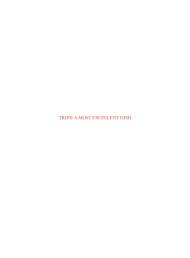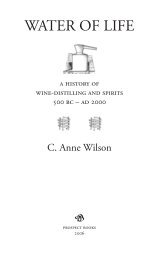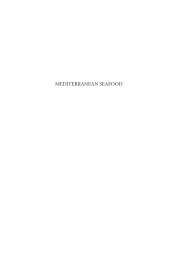RECIPES FROM CORSICA - Prospect Books
RECIPES FROM CORSICA - Prospect Books
RECIPES FROM CORSICA - Prospect Books
Create successful ePaper yourself
Turn your PDF publications into a flip-book with our unique Google optimized e-Paper software.
<strong>RECIPES</strong> <strong>FROM</strong> <strong>CORSICA</strong>
N<br />
Golfe<br />
de Porto<br />
Golfe<br />
de Sagone<br />
AJACCIO °<br />
Golfe d’Ajaccio<br />
Calvi °<br />
Calenzana °<br />
Olmeto °<br />
L’Île Rousse °<br />
2706m<br />
Propriano °<br />
Sartène °<br />
2622m<br />
1340m<br />
Bonifacio °<br />
St Florent °<br />
°Corte<br />
2134m<br />
°Zonza<br />
Strait of Bonifacio<br />
Cap Corse<br />
°Bastia<br />
°Borgo<br />
°Porto-Vecchio<br />
°Cervione<br />
°Aléria<br />
SARDINIA<br />
<strong>CORSICA</strong><br />
drawn by James Stewart
<strong>RECIPES</strong> <strong>FROM</strong><br />
<strong>CORSICA</strong><br />
ROLLI LUCAROTTI<br />
Illustrated with sketches of Corsica<br />
by<br />
Gilles Charbin<br />
PROSPECT BOOKS<br />
2004
First published in Great Britain in 2004 by <strong>Prospect</strong> <strong>Books</strong>, Allaleigh<br />
House, Blackawton, Totnes TQ9 7DL.<br />
©2004, Rolli Lucarotti<br />
©2004, illustrations, Gilles Charbin<br />
-<br />
cordance with the Copyright, Designs & Patents Act 1988.<br />
No part of this publication may be reproduced, stored in a retrieval<br />
system, or transmitted in any form or by any means, electronic,<br />
mechanical, photocopying, recording or other wise, without the<br />
prior permission of the copyright holder.<br />
British Library Cataloguing in Publication Data:<br />
A catalogue entry for this book is available from the British Library.<br />
ISBN 1-903018-27-7
CONTENTS<br />
PREFACE 7<br />
LIST OF <strong>RECIPES</strong> 9<br />
INTRODUCTION 15<br />
SOUPS 29<br />
FIRST COURSES AND CANAPÉS 43<br />
FISH AND SHELLFISH 59<br />
GAME AND BIRDS 105<br />
LAMB AND GOAT 117<br />
THE WHOLE HOG 131<br />
BEEF AND VEAL 145<br />
VEGETABLE DISHES, PASTA, AND SOME SAUCES 153<br />
CHESTNUTS 181<br />
SWEET DISHES AND BISCUITS 195<br />
A NOTE ABOUT BOOKS 221<br />
INDEX 222<br />
5
For Charlie
PREFACE<br />
I<br />
decided to write a book of recipes of Corsican food<br />
after being unable to find one for a friend who was<br />
visiting this lovely island. I spent two years searching for and<br />
testing recipes and would like to thank my family and many friends<br />
who tasted and commented on the results. Particular thanks must<br />
go to Cathy Texier for her careful and thorough explanations of<br />
pork recipes and to Marcelle Stefanelli for many other contributions.<br />
The late Dorothy Carrington was always ready, over our weekly<br />
cup of tea, with advice and encouragement. And special thanks to<br />
my mother who instilled in me a love of good food and who taught<br />
me how to cook, to John who encouraged me to write, and to my<br />
daughter Charlie without whose good-humoured help this book<br />
<br />
Rolli Lucarotti,<br />
Ajaccio, April 2004.<br />
7
LIST OF <strong>RECIPES</strong><br />
SOUP<br />
Corsican country soup 31<br />
Holy Thursday chick-pea soup 33<br />
Bread soup 34<br />
Dried chestnut soup 34<br />
Broad bean soup 35<br />
Swiss chard and brocciu soup 36<br />
Pumpkin soup 36<br />
Garlic soup 37<br />
Leek and red bean soup 38<br />
Onion soup with eggs 39<br />
Wood pigeon soup 40<br />
Fish soup 40<br />
Rouille 42<br />
FIRST COURSES AND CANAPÉS<br />
Anchovies in oil 45<br />
Aubergines in oil 46<br />
Mushrooms in oil 46<br />
Fried ceps with garlic 48<br />
Poutargue 49<br />
L’anchoïade 49<br />
Leek fritters 50<br />
Brocciu and anchovy tarts 51<br />
Brocciu and mint omelette 52<br />
Courgette and potato omelette 52<br />
Eggs with tomatoes 53<br />
Herb tart 55<br />
Swiss chard and brocciu turnovers 56<br />
Snails in wine sauce 58<br />
9
Recipes from Corsica<br />
FISH AND SHELLFISH<br />
Oursinado 64<br />
Hollandaise sauce 65<br />
<br />
<br />
Sea urchins with eggs 67<br />
Bouillabaisse 68<br />
Rouille, mark two 69<br />
Bouillabaisse of salt cod 70<br />
Bouillabaisse of eggs 71<br />
Salt cod and leeks 71<br />
Salt cod with Swiss chard and raisins 73<br />
Squid in tomato sauce 74<br />
Stuffed squid in crab sauce 75<br />
Octopus with potatoes 76<br />
Escabeche 77<br />
Eels with wild chicory 78<br />
Langouste with spaghetti and two sauces 79<br />
Langouste and potatoes 81<br />
Langouste gratin 83<br />
Fishermen’s langouste 84<br />
Poutine fritters 85<br />
Poutine fritters, another way 88<br />
Poutine stew 86<br />
Poutine soup 87<br />
Skate with garlic 88<br />
Moray eel with raisins 89<br />
Red mullet with anchovies 91<br />
Golden fried sardines 92<br />
Sardines stuffed with chard and brocciu 92<br />
Sardines in tomato sauce 94<br />
<br />
Sea bream with tomatoes 96<br />
Baked sea bream with brocciu 97<br />
Baked sea bream with herbs 98<br />
Trout in red wine sauce 99<br />
Trout in garlic sauce 101<br />
10
Recipes from Corsica<br />
Sea anemone fritters 102<br />
Ragoût of tuna 103<br />
<br />
GAME AND BIRDS<br />
Civet of hare 107<br />
Blackbirds with cherries 108<br />
Blackbirds in potato boats 110<br />
Chicken with sage 111<br />
Chicken with tomatoes and peppers 112<br />
Pigeons with peas 113<br />
Roast woodcock 114<br />
Partridge with cabbage 115<br />
Rabbit with garlic and wine 116<br />
LAMB AND GOAT<br />
Milk-fed lamb 120<br />
Lamb stew with haricots 121<br />
Kid stew 122<br />
Sweet and sour lamb stew 123<br />
Lamb with olives 124<br />
Stuffed shoulder of kid or lamb 125<br />
Roast shoulder or leg of lamb 126<br />
Kid or lamb stew with new potatoes 127<br />
Lamb or kid’s tripe 128<br />
Rivia 129<br />
Misgiscia 130<br />
THE WHOLE HOG<br />
Lentils with <br />
134<br />
Pig’s stomach stuffed with chard 135<br />
Black pudding with onions 137<br />
Stuffed pig’s stomach 138<br />
Stuffed appendix 139<br />
Razzica 140<br />
Brawn 141<br />
11
Recipes from Corsica<br />
12<br />
<br />
<br />
Wild boar stew 143<br />
BEEF AND VEAL<br />
Veal stew with peppers 148<br />
Veal stew with olives 149<br />
Veal and aubergine stew 150<br />
Beef stew 151<br />
Meatballs 152<br />
VEGETABLE DISHES, PASTA AND SOME SAUCES<br />
Stuffed artichokes 155<br />
Stuffed aubergines 157<br />
Aubergine lasagne 158<br />
Aubergines cooked with tomatoes 158<br />
Stuffed ceps 159<br />
Cos lettuce stuffed with brocciu 160<br />
Cabbage stuffed with <br />
160<br />
Fennel gratin 162<br />
Green beans and leeks with tomatoes 163<br />
Courgette fritters 164<br />
Courgette galettes 165<br />
Courgette casserole 165<br />
White beans and mushrooms 166<br />
Stuffed onions 167<br />
Potato tarts 168<br />
Potato and tomato bake 169<br />
Chickpea salad 169<br />
<br />
<br />
Tomatoes stuffed with olives 172<br />
Pasta with meat sauce 172<br />
Swiss chard and cheese dumplings 173<br />
Cheese ravioli 175<br />
Swiss chard cannelloni 176<br />
Peveronata sauce 178
Recipes from Corsica<br />
Vinaigrette with anchovies 178<br />
Another tomato sauce 179<br />
Garlic sauce 180<br />
CHESTNUTS<br />
Pulenda 184<br />
<br />
<br />
<br />
<br />
<br />
<br />
Boiled chestnuts 186<br />
<br />
<br />
<br />
<br />
<br />
<br />
<br />
<br />
<br />
Puffy chestnut fritters 192<br />
<br />
<br />
<br />
SWEET DISHES AND BISCUITS<br />
Fiadone 197<br />
Falculelle 198<br />
Caccavellu 199<br />
Caccavellu with brocciu 200<br />
Fried biscuits 200<br />
Rice fritters 202<br />
Brocciu fritters 203<br />
Potato fritters 204<br />
Swiss chard and raisin fritters 204<br />
Apple galettes 206<br />
Pumpkin and raisin galettes 206<br />
New Year’s Day cake 207<br />
Dead Men’s bread 208<br />
White wine biscuits 209<br />
Aniseed biscuits 210<br />
13
Recipes from Corsica<br />
14<br />
<br />
Almond macaroons 212<br />
Floating islands 213<br />
Savoie biscuit 214
INTRODUCTION<br />
I<br />
fell under the spell of Corsica when I arrived in 1970,<br />
with my husband John and our baby daughter Charlie,<br />
aboard our catamaran Ratu Etai<br />
by a mistral, the strong wind that shrieks down the Rhône valley<br />
into the Mediterranean, we came to shelter from the rough seas<br />
and stayed for over thirty years.<br />
<br />
school-going age, we spent more and more time ashore, renting a<br />
<br />
business while John continued writing for television. The catering<br />
business led to my opening a restaurant and thereafter I became<br />
interested in the cookery of Corsica itself.<br />
<br />
<br />
food in restaurants. Although it was eaten at home, restaurateurs as-<br />
<br />
chips. It is only in the last few years that Corsican speciality restaurants<br />
have begun to be found in every small town on the island and<br />
that Corsican produce has begun to be exported. The sheer quality<br />
of the products ensures their success, and enterprising manufacturers<br />
are improving packaging and distribution all the time.<br />
<br />
<br />
<br />
<br />
with no oven temperatures or explicit quantities given. ‘Until done’<br />
was the way most ended and it was only by trial and error that one<br />
<br />
reason that oven temperatures were never stated was because, until<br />
<br />
<br />
<br />
-<br />
tities, one learned by watching one’s mother or grand mother. As<br />
<br />
how much ‘some’ was.<br />
15
Recipes from Corsica<br />
The following recipes are traditional. Originally the only fats<br />
used were lard or oil, preferably olive oil, but nowadays this is often<br />
replaced with margarine or butter.<br />
A POTTED ISLAND HISTORY<br />
<br />
<br />
the sea. Sitting amid translucent, unpolluted waters, it is situated 125<br />
kilometres south of the Gulf of Genoa, 82 kilometres west of the Italian<br />
<br />
Sardinia and some 450 kilometres east of Spain. Its strategic position<br />
in the Mediterranean means that it has been constantly invaded,<br />
fought over and occupied by different peoples.<br />
Ancient invaders included the Greeks, who founded the town<br />
<br />
BC, and introduced<br />
vines, olive trees and cereals to the island, the Etruscans,<br />
then Greeks again before the Carthaginians. In 260 BC the Romans<br />
arrived and eventually, a century later, conquered the whole island.<br />
<br />
centuries AD<br />
to be suc ceeded by the Lombards. They didn’t stay long and the<br />
island was put under Papal protection, which unfortunately didn’t<br />
stop the Saracens from launching attacks and incur sions over the<br />
next three centuries.<br />
In 1077 the Bishop of Pisa was sent to exercise Papal authority<br />
over the island, an authority that continued for two centuries, in<br />
<br />
Kingdom of Aragon for regional supremacy. Genoa prevailed and<br />
ruled the island until 1729 when Corsicans rebelled and sought<br />
<br />
<br />
<br />
birth, Corsica became French.<br />
From even this extremely potted history of Corsica, it is evident<br />
-<br />
16
Recipes from Corsica<br />
sine of the island. Those readers who wish to know more of the<br />
topography and historical background can immerse themselves in<br />
Corsica’s rich bibliography. Modern works include volumes in the<br />
Rough Guide and Lonely Planet series. Looking a little further back,<br />
there is the matchless book by Dorothy Carrington, Granite Island,<br />
<br />
The Journal of a Landscape<br />
Painter in Corsica which came out in 1870.<br />
CLIMATE AND TOPOGRAPHY<br />
An important aspect of agriculture is the fact that Corsica is the<br />
only island in the Mediterranean with a high rainfall; more in fact<br />
than that of the Paris region. The rain falls mainly in the mountain<br />
<br />
<br />
<br />
rivers that run down to the sea water the lands around them.<br />
Add to this a temperate climate with plenty of sunshine and you<br />
have ideal conditions for cultivating the soil, although the fact that<br />
a lot of the island is made up of granite rockface limits the extent<br />
of arable land.<br />
From the permanently snow-capped top of Monte Cinto, down<br />
through forests of maritime and Laricio pines, chest nut forests,<br />
<br />
<br />
and cactus plants, an enormous variety of plant life can be found in<br />
<br />
on the island, 300 are native.<br />
But perhaps the most important consideration is that over one<br />
<br />
de la Corse. There’s no intensive farming here with its accompanying<br />
pollution. Instead, all efforts are being made to guarantee that<br />
traditional methods are maintained and that produce has its own<br />
label of quality and authenticity.<br />
17
Recipes from Corsica<br />
PEOPLE AND PLACES<br />
Corsica has a population of around 260,000, well over half of<br />
<br />
Porto-Vecchio. Readers will see, from the names of dishes and<br />
foodstuffs that I have given at the heads of recipes, that the Corsican<br />
language is alive and well, although the mainland government<br />
made every effort to annihilate it in favour of French. It has been<br />
taught in schools only in the last twenty years. Although the island<br />
is small, the topography is complex and the human history likewise.<br />
<br />
the island to another. Spellings are often dissimilar, and different<br />
<br />
<br />
<br />
staple supporting the hard peasant life and thus, one might think,<br />
a candidate for a single name or description, it is called brillulis in<br />
the north and granahjoli in the south of the island.<br />
Migration to the coasts and desertion of the mountain villages,<br />
<br />
<br />
after the Second World War, when the American army sprayed the<br />
mosquito-infested eastern coastline with DDT, ridding the area of<br />
the malaria that had affected it for so long. As the coast became<br />
increasingly populated, so the villages emptied, save for the elderly<br />
who retired to their family homes and certain stalwarts who clung<br />
to the traditional way of life.<br />
In the summer the villages come to life again as a large part of<br />
<br />
the heat of the coast and install themselves in their ancestral homes<br />
in the mountains; Corsicans from the mainland come home for<br />
<br />
festivals of Christmas, Easter and All Saints’ Day.<br />
THE <strong>CORSICA</strong>N KITCHEN<br />
Traditional dishes are prepared for feast days, often varying from one<br />
village to another. The recipes are not written down but passed from<br />
18
Recipes from Corsica<br />
one generation to the next. They are usually learnt as the children<br />
help their mothers or aunts in the kitchen, although the men are<br />
<br />
Until the middle of the twentieth century, cookery in the villages<br />
was based on local produce. People ate what they grew and reared<br />
in their gardens and smallholdings as the seasons changed. Food<br />
was preserved for the winter by drying, salting, pickling and smoking.<br />
Half the house was given over to the storing of food: dried<br />
fruits, chestnuts, pulses and cereals in the attic; and hams, sausages,<br />
<br />
<br />
<br />
were sometimes baked in the communal bread oven in the village.<br />
On fête days, no cooking was undertaken, everything having been<br />
made ready beforehand.<br />
Meals were prepared according to what was in season and generally<br />
followed a weekly pattern. Although there was nothing overly<br />
elaborate, pride was taken in the quality and freshness of ingredients<br />
and the ingenuity shown in the use of the abundant herbs that<br />
grow wild all over the island.<br />
Nothing went to waste; a glut of tomatoes in the summer would<br />
be left to ferment in wooden barrels for a few days to drain the fruit<br />
<br />
on wooden boards in the sun until it darkened in colour. After that,<br />
<br />
<br />
<br />
of olive oil, to be used during the winter months.<br />
Bread was baked once a week in the communal oven. Stale bread<br />
was used to make a soup of bouillon, garlic and slices of bread<br />
sprinkled with grated cheese. Often, the evening meal was simply<br />
a bowl of soup followed by cheese and, sometimes, dried fruit –<br />
though the soup in question was usually a hearty vegetable mixture<br />
<br />
Until the beginning of the nineteenth century, most islanders,<br />
apart from the very rich, ate fresh meat only on special occasions.<br />
Cabri <br />
<br />
at Christmas time. Milk-fed lamb was also highly rated and was<br />
usually eaten at Easter.<br />
19
Recipes from Corsica<br />
The Corsicans have been shepherds for centuries and still follow<br />
<br />
pastures for the summer and back down to the plains and valleys to<br />
spend the winter. The animals are kept for their milk, which is used<br />
<br />
animals have fed.<br />
PIGS AND WILD BOAR<br />
<br />
life. Until the 1950s most families in the countryside kept two pigs<br />
porci mannarini<br />
the other to be kept for the following year. The pigs were slaughtered<br />
at a later age than intensively-farmed pigs, usually over fourteen<br />
months and sometimes up to thirty-six months old. This is still the<br />
<br />
proportion of fat. Then as now, the pigs were semi-wild and free<br />
to roam the forests during the day, feeding on chestnuts and roots,<br />
and sometimes mating with wild boars.<br />
Nothing of the pig was wasted, from the tip of its tail to its ears.<br />
Most of it was made into sausages and hams, which were cured<br />
and dried in the mountain air or smoked over the chimney in the<br />
house. Some of the pork was eaten fresh, and the blood was made<br />
<br />
boudin<br />
stuffed with the chopped heart and tongue of the pig mixed with<br />
<br />
ghialaticciu<br />
ventra<br />
<br />
Christmas and was considered a great delicacy. The small amount<br />
of pork that was eaten fresh was quite simply pre pared, grilled or<br />
fried with herbs.<br />
The fate of the pig hasn’t changed much today. Charcuterie is<br />
still produced all over Corsica and is much appreciated by visitors,<br />
though to keep up with increasing demand, and EU requirements,<br />
<br />
-<br />
portant cured meats are panzetta and prizuttu. Panzetta, which is used<br />
21
Recipes from Corsica<br />
in many of the recipes which follow, is salted and air-dried breast<br />
of pork, similar to the Italian pancetta. It can be also lightly smoked.<br />
The extra age of the pigs at slaughter means it is especially fatty.<br />
British readers can substitute pancetta <br />
<br />
Prizuttu is a cured ham and looks very<br />
like its cousin, the Spanish Serrano ham. It is salted, rinsed and then<br />
rubbed with pepper or razzica <br />
before being air-dried for between six and eighteen months. Very<br />
large hams may take up to two years to cure.<br />
Wild boar is hunted for its meat, which holds a high place in<br />
Corsican gastronomy. Of the 30,000 or so wild boar on the island,<br />
about 12,000 are killed annually. The hunt is a tradition and the<br />
<br />
<br />
<br />
<br />
<br />
one.<br />
The season starts in the middle of August and continues until<br />
<br />
<br />
<br />
butcher’s shop. It is of an excellent quality, the wild boar having<br />
lived off the abundant herbs of the maquis and chestnuts from the<br />
forests that cover much of the island.<br />
<br />
sausages. It is sometimes marinated before being cooked and is<br />
often served with pasta.<br />
Other game includes hare, pheasant, guinea fowl, wood cock and<br />
blackbirds and thrushes. These last two are now protected but are<br />
undoubtedly still eaten in private homes.<br />
TASTES OF HONEY<br />
Honey has held an important place in the Corsican economy from<br />
before the birth of Christ. The Romans imposed a tribute of 65 tons<br />
of beeswax on Corsica, which gives an idea of the importance of the<br />
production. Honey and beeswax were traded from the natural harbours<br />
of the island. Records do not show trading in medieval times,<br />
22
Recipes from Corsica<br />
but it reappears in the middle of the nineteenth century with exports<br />
to Italy until the end of the century when an epidemic of acariasis<br />
struck Corsican apiculture. The industry has steadily revived since<br />
the 1970s. There are now 22,000 hives on the island, two-thirds of<br />
which are in the north. Honey is divided into six distinct varieties<br />
according to altitude and season. They are perfumed with a multi tude<br />
of different plants. The varieties are Printemps, Fleur du Maquis,<br />
<br />
<br />
Appellation d’Origine Con-<br />
trôlée<br />
<br />
had been seeking for twelve years and one that has not yet been<br />
awarded to any other honey in the world.<br />
CEDRATS AND OTHER FRUITS<br />
Citrus fruits grow abundantly on the island – oranges, lemons,<br />
mandarins and cedrats. Corsica is one of the few places in the<br />
<br />
cédrats<br />
<br />
Citrus medica<br />
<br />
Asia. The Corsican variety is especially sweet. The island is also the<br />
second-largest producer in Europe, and the largest in France, of<br />
clementines, although these have only been cultivated in quantity<br />
<br />
value of fruit grown on the island.<br />
Cherries and plums, particularly greengages which used to be<br />
<br />
<br />
peaches, pears, medlars, cherries, necta rines, apricots and apples.<br />
Fig trees are seen in most villages and prickly pears are everywhere.<br />
They are sold, ready-peeled, in plastic bags on street corners.<br />
Plantations of kiwis, limes and pomolos have recently been introduced<br />
on the east coast, as have avocados, with varying success.<br />
<br />
Arbutus<br />
maquis, <br />
mulberries, myrtle-berries and strawberries, while in the 1950s<br />
23
Recipes from Corsica<br />
cultivated strawberries and raspberries were introduced. Of course,<br />
vine terraces have criss-crossed the landscape for over two thousand<br />
<br />
<br />
eau de vie to make .<br />
24<br />
<br />
walnut trees are abundant, particularly in the region of Cervione<br />
on the east coast. Olive trees are part of the maquis and grow wild<br />
all over the island. Olive oil mills are being restored and the soft<br />
and fruity oil, once known as the best in the Mediterranean, can<br />
<br />
revival too, with the cultivation of several hundreds of hectares on<br />
the east coast. Corsican almonds are known for the softness of their<br />
<br />
<br />
Add to such abundance wild plants and herbs, mush rooms, snails,<br />
freshwater trout and eels – it’s not hard to see how Corsican bandits<br />
managed to survive on their own in the maquis for years on end!<br />
BROCCIU, PRINCE OF CHEESES<br />
Bruccio, brocciu or brucciu is the most famous of all Corsican cheeses<br />
and the only one to have been given an Appellation d’Origine Contrôlée.<br />
Made of goat or sheep’s milk, it is served very fresh, usually as a<br />
dessert, on its own or with a sprinkling of sugar and a spoonful or<br />
two of eau de vie <br />
<br />
<br />
Laetitia, Napoleon Bonaparte’s mother, was so inordi nately fond<br />
of brocciu that she had several Corsican sheep brought to Paris for<br />
fresh supplies; alas, the grass on which the sheep were fed in Rueil<br />
Malmaison didn’t have quite the same perfume as the herbs of the<br />
maquis.<br />
<br />
petit lait<br />
cream sheep or goat’s milk. A little salt is added and the milk is<br />
gently stirred and reheated. The creamy solids that rise to the<br />
surface are skimmed off and carefully placed in small woven tubs
Recipes from Corsica<br />
to drain. Produced between November and July, to be eaten within<br />
brocciu is a light, creamy mass of delicatelyperfumed<br />
curds. It cannot be compared to any other curd cheese.<br />
Brocciu is employed extensively in cooking, for omelettes, pastries<br />
<br />
<br />
brocciu called passu is put in savoury pastries and vegetable dishes.<br />
When the cheese has hardened further, it is grated over dishes or<br />
used in soups, sometimes having been soaked in water for a few<br />
hours to soften it.<br />
For the purpose of my recipes, fresh brocciu can be replaced with<br />
ricotta or a mixture of ricotta and cream cheese. Cream cheese<br />
alone is too dense, and the little grains in cottage cheese are too<br />
rubbery. Feta cheese or Caerphilly can be used to replace slightly<br />
older brocciu. For the harder brocciu used for grating, try Parmesan<br />
or any other hard cheese. Sardinian tomme would be the closest, or<br />
you could use a grana from the Italian delicatessen.<br />
Bastelicacciu<br />
raw sheep’s milk eaten while it is still young and tender. It is best,<br />
like all cheeses, when produced artisanally.<br />
Calinzana <br />
soft, square-shaped sheep’s cheese with a washed crust and a characteristic<br />
slightly pungent taste.<br />
Cuscio is a pressed cheese made of sheep and/or goat’s milk,<br />
made principally in the south of the island. This is the famous<br />
<br />
<br />
-<br />
gots, either loved or loathed.<br />
Niolu also produces a cheese of the same name which is considered<br />
the best in Corsica. Made of goat or sheep’s milk, the cheeses<br />
are tender and can be pungent and peppery or creamy and mild,<br />
depending on their age.<br />
<br />
rival those of the Niolu. Also made with raw goat or sheep’s milk,<br />
they have an orange-red crust and a subtle cream-coloured interior.<br />
Another speciality, alas rarely now seen for sale, comes from the<br />
region of Porto-Vecchio around the time of sheep shearing. Ricotta<br />
25
Recipes from Corsica<br />
<br />
<br />
until they are white hot, then plunging them into a cauldron of<br />
boiled ewe’s milk. As the cream starts to form, the stones are removed<br />
and rennet and a little sugar added. When cool, this slightly<br />
<br />
the same as the Italian cheese of the same name.<br />
ISLAND HERBS<br />
-<br />
naparte famously said. One has only to step off a ’plane arriving at<br />
<br />
maquis, to<br />
understand what he meant. The maquis is the dense shrub that covers<br />
a large part of the island, which is made up of various herbs and<br />
plants that give their particular savour to the produce and cuisine<br />
of Corsica. Here is a list of some of the many herbs to be found<br />
growing wild on the island, and their culinary uses.<br />
u porru salvaticu<br />
tarts.<br />
l’acetula<br />
bettes, blettes, biettule<br />
a burrascia<br />
lattaredda or lattarepulu<br />
tarts and many more things.<br />
e rice bice<br />
a romacia<br />
u sparacu<br />
l’erba barona<br />
a pimpanella<br />
u criscione -<br />
<br />
<br />
a genziana<br />
u lupinu<br />
water for several days.<br />
26
Recipes from Corsica<br />
a menta<br />
a nepita<br />
pastries, sauces, etc.<br />
pedirossu<br />
u pulghju<br />
l’herbe de Saint-Laurent, used in soups, tarts, fritters.<br />
a rosula<br />
u rosamarinu<br />
salvia<br />
l’urticula<br />
viola<br />
27









